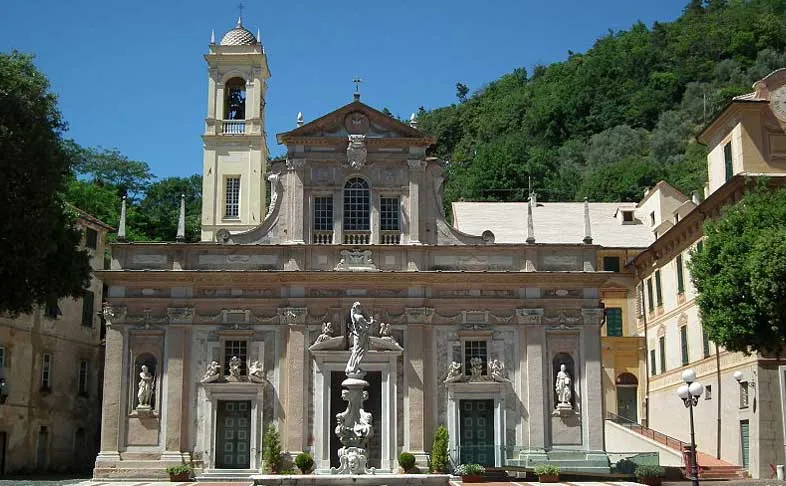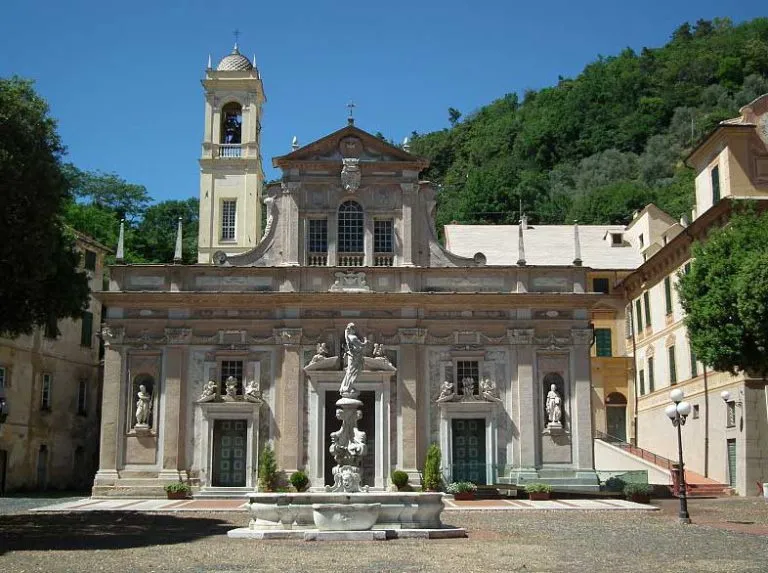
Introduction
The Sanctuary of Nostra Signora della Misericordia (Santuario Di Nostra Signora Di Misericordia) is a church and surrounding buildings located some six kilometers from the center of Savona, Liguria, northern Italy.
It is built on the site commemorating the apparition of the Virgin Mary to the shepherd and officially blessed Antonio Botta (18 March 1536). She appeared to the shepherd during a time of war between Savona and Genoa, and had the message inviting both parties to exercise “Misericordia e non Giustizia” (“Mercy and not Justice”).
The church is located about 6 kilometers from the center of the city. The present Renaissance church was designed by Pace Antonio Sormano in 1536-1540. The Baroque facade was designed and built by Taddeo Carlone in 1609-1611. The interior is highly decorated by prominent architects and artists. The buildings surrounding the church became a hospice and orphanage.
The main altar is attributed to the studio of Francesco Maria Schiaffino. The cupola frescoes are by Bernardo Castello.
The four pinnacles were decorated by the painter Narducci. The vault of the nave was decorated by Narducci, Riva, Giuseppe Ghislandi, and the stuccoist Castori.
The left aisle and chapels contain two altarpieces, a Madonna della Neve (1st chapel) and a Nativity (3rd chapel) by Bernardo Castello. The second chapel has a marble relief by Gianlorenzo Bernini. The third chapel has a marble relief of the Annunciation by Andrea Semino.
The right aisle contains an altarpiece of the Immaculate Conception by Paolo Gerolamo Brusco (1742-1820), a Nativity by Orazio Borgianni (1578-1616), a Presentation of Mary at the Temple by Domenichino. The Crucifix at the end of the aisle is by Giovanni Battista Paggi (1554-1627).
The chorus has a magnificently designed intarsio or wood inlay panels by Vincenzo e Giuseppe Garassino, completed in the 18th century. The central panel reproduces a painting by Giuseppe Agostino Ratti. The apse angel frescoes were completed in an antique fashion by Eso Peluzzi in 1928. The crypt statue of the virgin is by Pietro Orsolino.
History of Sanctuary of Nostra Signora della Misericordia, Savona
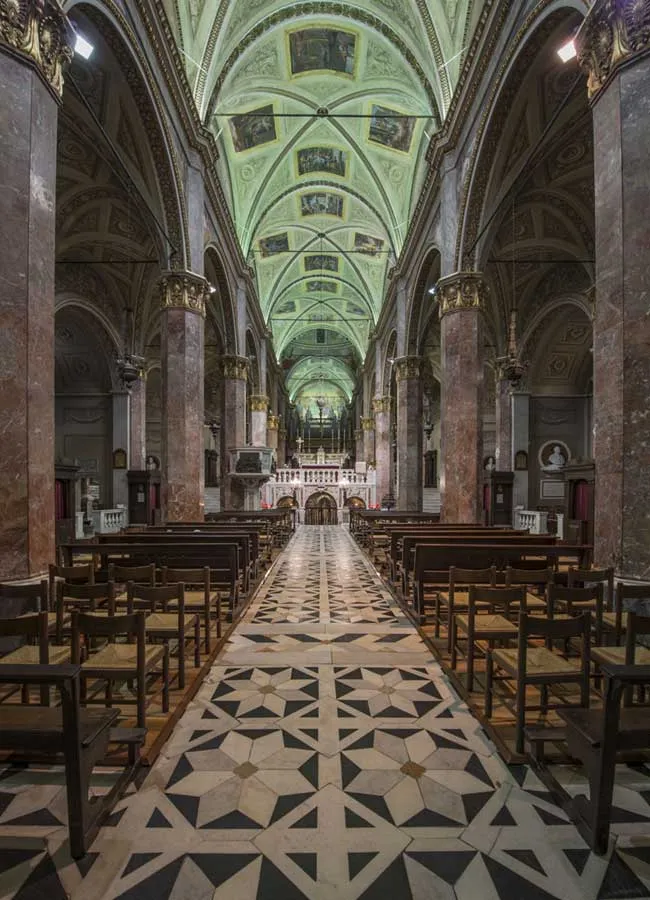
The Sanctuary originates from the prodigious apparition of the Madonna to the farmer Antonio Botta, which took place on 18 March 1536 in the San Bernardo valley near Savona. The emotion aroused by the event is demonstrated by the speed with which the religious complex was built in the summer of the same year.
The basilica, built by resolution of the Great Council of Savona by the Lombard Pace Antonio Sormano, has an interior with three naves supported by pillars and flanked by side chapels; crypt and raised presbytery. At the same time as the church, the first hospice for pilgrims, the residence for the chaplains and the inn were built.
At the turn of the sixteenth and seventeenth centuries, with the construction of a larger hospice and the new facade of the church, the beautiful square was created.
During the 17th century, the nine votive chapels that mark the pilgrims’ route starting from Lavagnola were built; the Crocetta chapel dates back to 1680, erected on the hillock where a cross commemorated another apparition of the Virgin to Father Agostino of Genoa (March 18, 1580). In 1708 the fountain was placed in the center of the square.
Architecture of Sanctuary of Nostra Signora della Misericordia, Savona
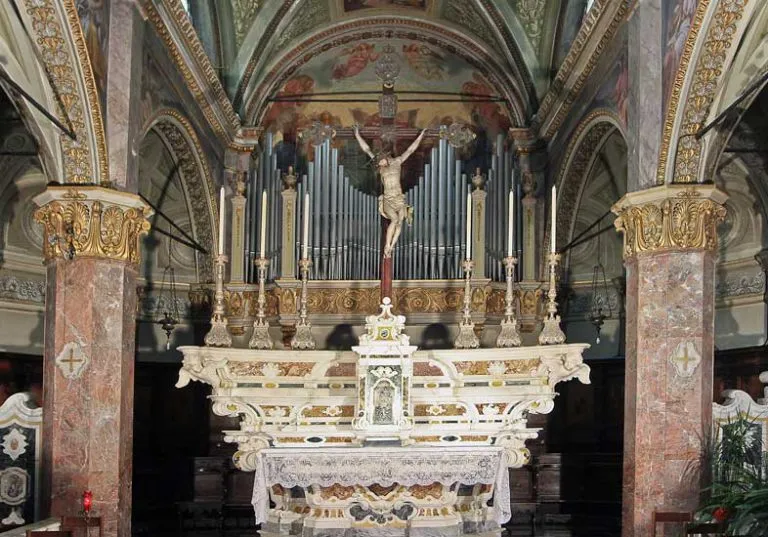
The counter-façade, the vault of the nave and the dome were decorated with a campaign of frescoes by the Genoese painter Bernardo Castello, which dates back to around 1610: the artist, at the height of his fame at that time, had obtained the commission thanks also to the support of the Savonese poet Gabriello Chiabrera who celebrates the paintings in one of his songs.
In view of the tercentenary of the apparition (1836), the decorations of the church were renewed by a team of Lombard artists: all the ornamental parts are completely redone in an elegant neoclassical style, while Pietro Narducci restores the panels of the Castle with the Stories of the Virgin, adding the monumental figures of angels above the arches of the main nave and the Evangelists in the pendentives of the dome.
The polychrome marble floor of 1860-1874 replaced the previous one, coming from the ancient cathedral of Savona; the pulpit is the work of the Genoese sculptor Onorato Toso (1915).
In the presbytery the altar and the access portals to the choir date back to 1756, while the large wooden Crucifix can be dated to between the 17th and 18th centuries. In the apse, the wooden choir from 1644 was subsequently enriched by inlaid dossals made by Vincenzo Garassini and completed, after his death (1888), by his son Giuseppe. The inlay behind the altar is instead due to Ignazio Scotto (1882).
For the celebrations of the fourth centenary, a new organ was installed, made by the Malvestio firm: this determined the need to modify the apse, which was later frescoed by Eso Peluzzi (1928).
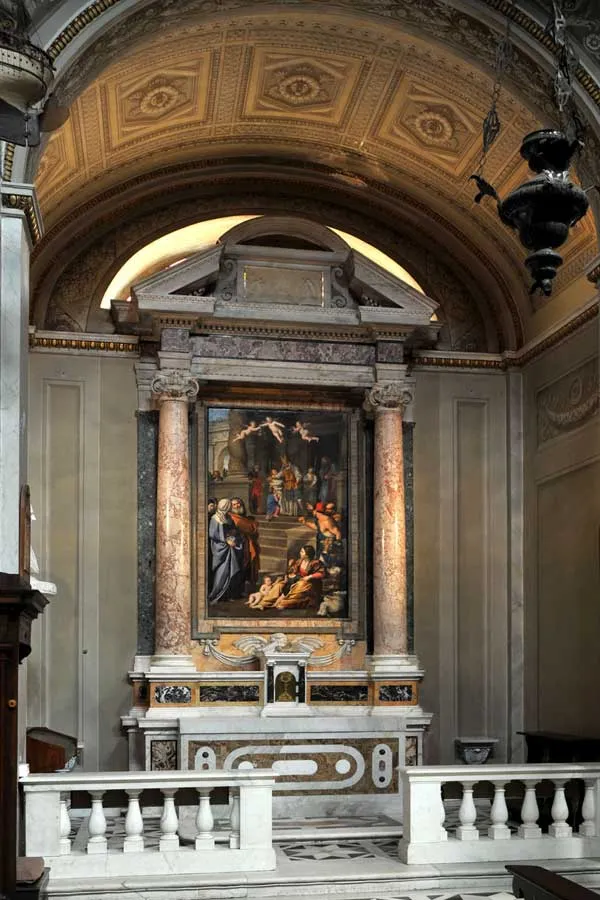
The Left Aisle
First Chapel: The marbles of the altar come from the sixteenth-century mausoleum of Cardinal Agostino Spinola, formerly in the church of San Domenico di Savona by Antonio Maria Aprile; the altarpiece, depicting the Annunciation, is the work of Andrea Semino (1585), the painting returned to its place during the 19th century, after being replaced with another of the same subject, executed around 1685 by Bartolomeo Guidobono (today in the Civic Museums of Palazzo Gavotti). On the side wall is fixed the sixteenth-century plaque with the original deposition of Blessed Antonio Botta with the story of the apparition.
Second Chapel: The altarpiece, depicting the Adoration of the Shepherds, is a work signed and dated by Bernardo Castello in 1593 and is enclosed in a beautiful coeval marble frame.
Third Chapel: The marble altar was commissioned by the Siri brothers, bankers from Savona in Rome, to Gian Lorenzo Bernini who directly follows the project and the execution of the architectural parts and entrusts the high relief with the Visitation to his collaborator Matteo Bonarelli. The work was placed in the church in 1665. The model, still preserved today, is exhibited in the Museum of the Sanctuary.
Fourth Chapel: The marble altar was made in 1614, while the altarpiece, representing the Madonna of the snow, was made in 1610 by Bernardo Castello. Both were commissioned by the Genoese nobleman Franco Borsotto who financed, in the first decades of the seventeenth century, an extensive restructuring campaign of the Sanctuary.
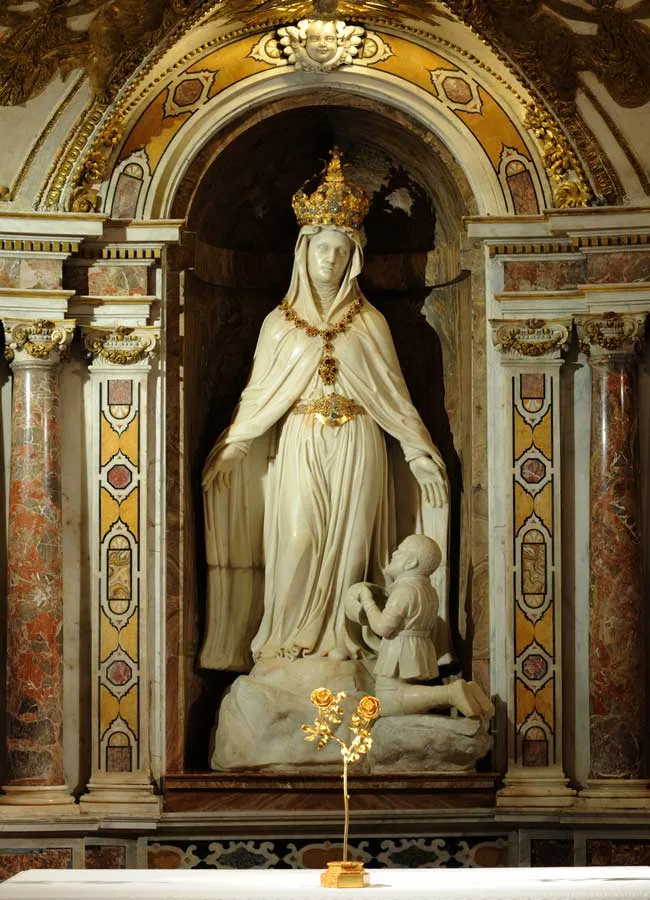
The Right Aisle
First Chapel: The altarpiece with the Immaculate Conception was executed in 1770 by Paolo Gerolamo Brusco on commission from Doge Francesco Maria della Rovere who in 1762 had already involved the artist in the new decoration of the Sistine Chapel in Savona; in the floor is the tomb of Blessed Antonio Botta, who died in 1550.
Second Chapel: The altarpiece with the Nativity of the Virgin is a work of the early maturity of Orazio Borgianni. It was painted around 1608-1610 probably for a member of the Pozzobonello family, bankers associated with the Gavottis, who already owned other paintings by the Roman artist in their collections. On the wall is the bust of Franco Borsotto, executed by Rocco Pellone in 1623, originally in the presbytery.
Third Chapel: The altarpiece depicting the Presentation of Mary in the temple was executed around 1623-1627 by Domenichino on commission from the Theatine father Lorenzo Gavotti, bishop of Ventimiglia and exponent of the Savonese banking family active in Rome.
Fourth Chapel: The patronage was granted, together with that of the Madonna della Neve, in 1611 to Franco Borsotto who in 1614 entrusted the execution of the altar to the sculptor Rocco Pellone and the painting with Christ Crucified to Giovanni Battista Paggi.
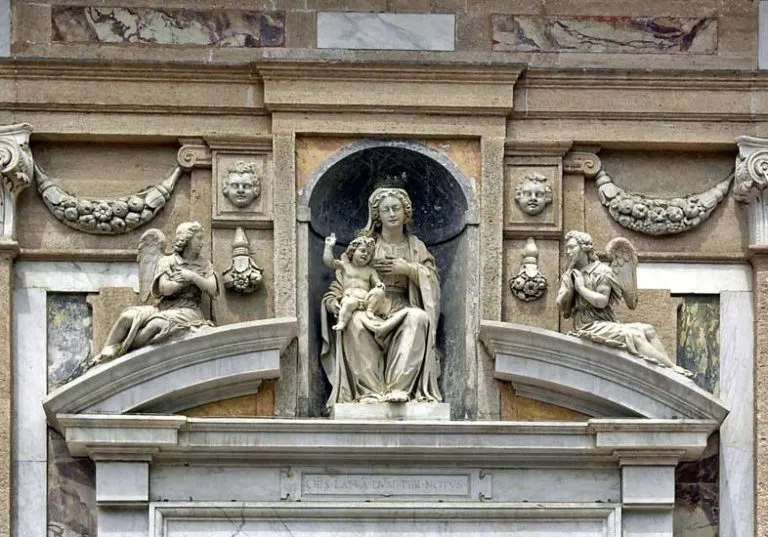
The Crypt
The elevation towards the nave is decorated with marble reliefs with musician angels: the work, attributable to Giovanni Battista and Cristoforo Orsolino, dates back to around 1635-1640.
The decoration of the sacellum, made precious by colored marbles and gilding, was financed by Franco Borsotto and was completed in 1616. The stuccoes of the vault, designed by the painter Lazzaro Tavarone, were executed by Gio. Antonio and Francesco Casella: they depict, in two medallions, the Madonna of Mercy who protects Savona and the Trinity.
In the central niche there is the sculptural group of the Madonna with Blessed Antonio Botta, a work commissioned in 1560 to Pietro Orsolino: the image, the devotional heart of the Sanctuary, immediately became the iconographic model for the Madonna of Savona. A small part of the rich collection of silverware and votive offerings donated to the church is displayed in the showcases.
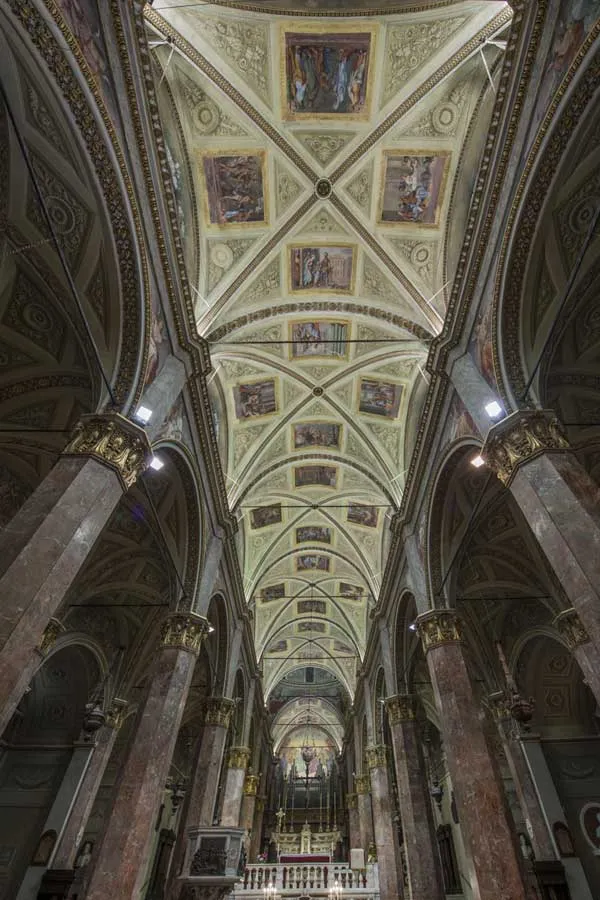
The Facade
The facade was designed by Taddeo Carlone di Rovio in refined late Mannerist forms and was completed between about 1609 and 1615: both the use of colored marbles and the chiaroscuro effects of the sculptures, made by the same, give it a particular elegance Carlone (St. John the Baptist, St. John the Evangelist), by Leonardo Mirano and by Francesco Fanelli (musician angels, Madonna and Child).
The coat of arms of Savona under the central tympanum recalls the patronage of the city over the building. The churchyard was redone in 1986.
The Bell Tower
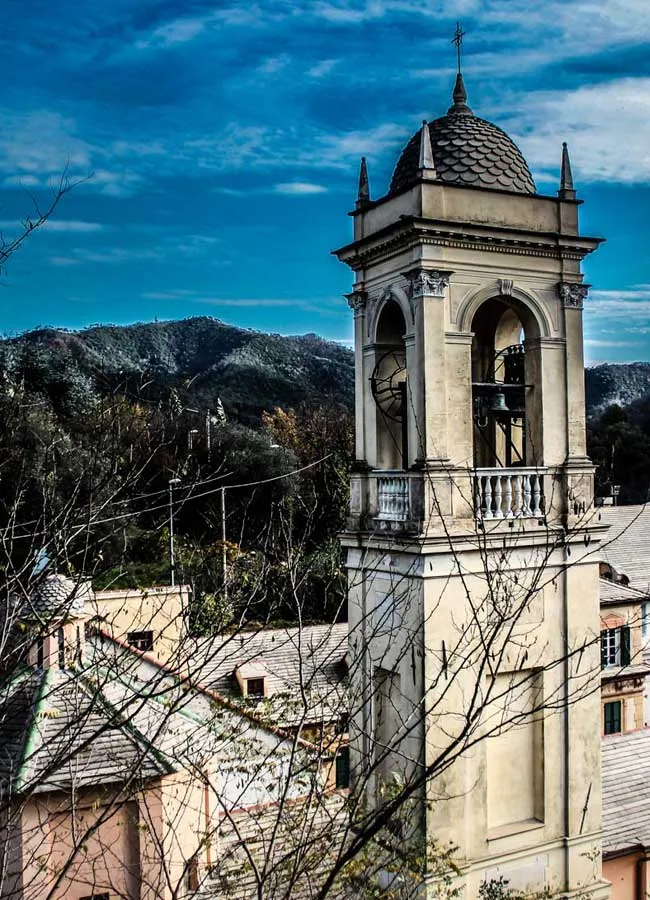
The bell tower is an addition that dates back to the mid-eighteenth century: it refers to the façade in the use of colored marbles, while the slate roof tiles recall those that surmount the chapels along the pilgrims’ way.
Hall of the Protectors
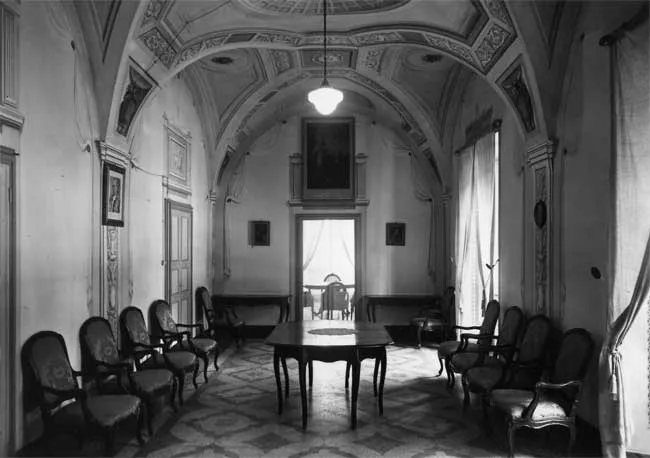
It was accessed from the entrance of the building, on the right with an elegant staircase, since 2007 with an inclined path of easy access to all. From chapter XIII of the first of the three books published in 1760 by Giacomo Picconi, the most informed historiographer of the Apparition, we know that the “governors” already met here in 1538, twice a week to deal with the interests of the Pious Work, replaced every two years, they were three and from 1661 six responsible for all the management of the Church and the Hospital.
From chapter VI, we know that the marble statue of the Madonna was kept here, which was demolished on the Porta del Molo from 1749 to 1766 and then moved to Piazza della Maddalena, in the Baroque aedicule, on the acute corner of Palazzo Della Rovere-Basso -Righteous.
In the 1980s, the three rooms, in succession, were the temporary headquarters of the paintings and drawings of the painter Eso Peluzzi (donation from 1969). About twenty years ago, the name of the decorator Giuseppe Francesco Bertolotto (1868 – 1933), from Savona, relative and collaborator of the famous painter Domenico Buscaglia (1828 – 1919).
The drawing is delicate, the chiaroscuro and the effects of relief are very measured in comparison with his works found in the City, in the vast first room with the slightly blued walls painted with light curtains and the ceiling with a fake coffered trompe – l’oeil dome between two fake cross vaults, with Greek frets, volutes, masks and pot-bellied vases full of flowers.
On the other hand, albeit coeval, the “grotesque” ceiling of the second room, with marked tones, dry brush strokes in lively contrasts, the tasty open umbrella between hanging festoons and the four coats of arms, perhaps of four corporations, of donors to the Opera Pia . The room is called “del Trono”: it houses the chair of Pope Pius VII.
The third Room “of the fireplace” awaits the restoration: the walls framed in fake architectures with classical moldings and the ceiling is in monochrome of the “empire” type.
The Museum
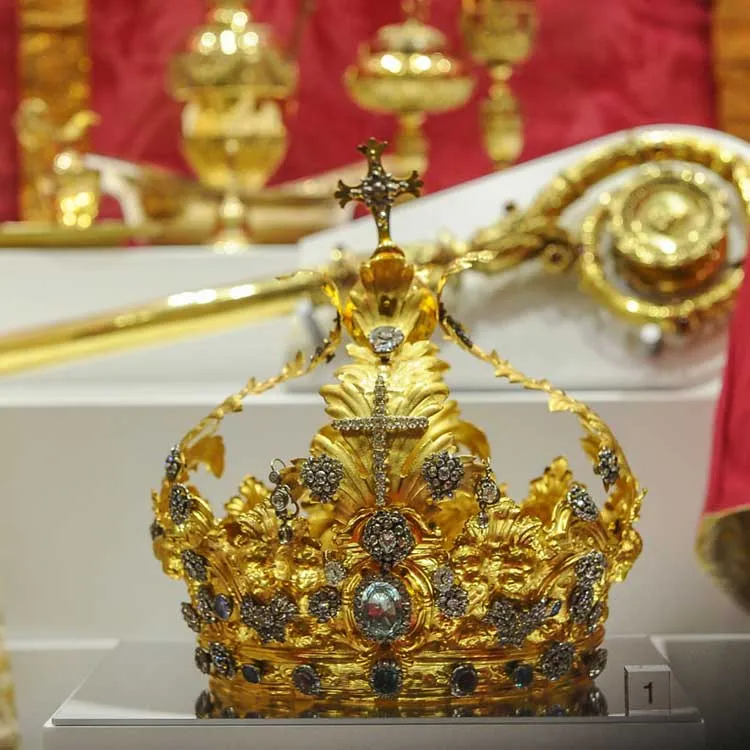
Inaugurated in 1959 and completely renovated in 1986-1987, it is housed in the wing that connects the Palazzetto del Duca di Tursi and the Ospizio de’ Poveri (the entrance is located on the right when looking at the facade of the Sanctuary, at the end of the inclined ramp).
The current Museum of the Sanctuary, rearranged in 2009, while maintaining in its fundamental contents the layout created in the 1950s, represents a single itinerary made up of the historic Museum of the Treasure and the Sala Peluzzi, inaugurated in the summer of 2008.
To ensure greater and more effective visibility of the works, the visitor is offered to travel the museum itinerary through the direct perception of the precious gifts offered as signs of devotion to the Virgin. The itinerary winds through five sections identified according to a chronological criterion (XVI-XVII centuries, Cell of precious objects, XVIII century, XIX century, Ex-voto) and guides us in the discovery of the great historical and artistic heritage on display.
Among the treasures kept there, we can mention: the Crown in gold and precious stones and the necklace that belonged to Princess Maria Anna of Savoy; the precious sacred vestments; the refined silver liturgical service donated by Mons. Agostino De Mari, as well as the collection of ex-votos, a sign of the gratitude of all those who have received graces from Our Lady of Mercy.
Feast Day - 24th September
The liturgical feast day of Our Lady of Mercy is celebrated annually in the General Roman Calendar on September 24.
Mass Time
Weekdays
Saturdays
Sundays
Church Visiting Time
Contact Info
Piazza Santuario, 17100,
Santuario, Savona, SV, Liguria, Italy
Phone No.
Tel : +39 019 879 025
Accommodations
How to reach the Sanctuary
Genoa Airport also named Christopher Columbus Airport, and commonly named Aeroporto di Genova-Sestri Ponente is an international airport in Genoa, Italy is the nearby Airport to the Sanctuary.
Santuario Train Station in Santuario, Province of Savona, Italy is the nearby Train Station to the Sanctuary.

